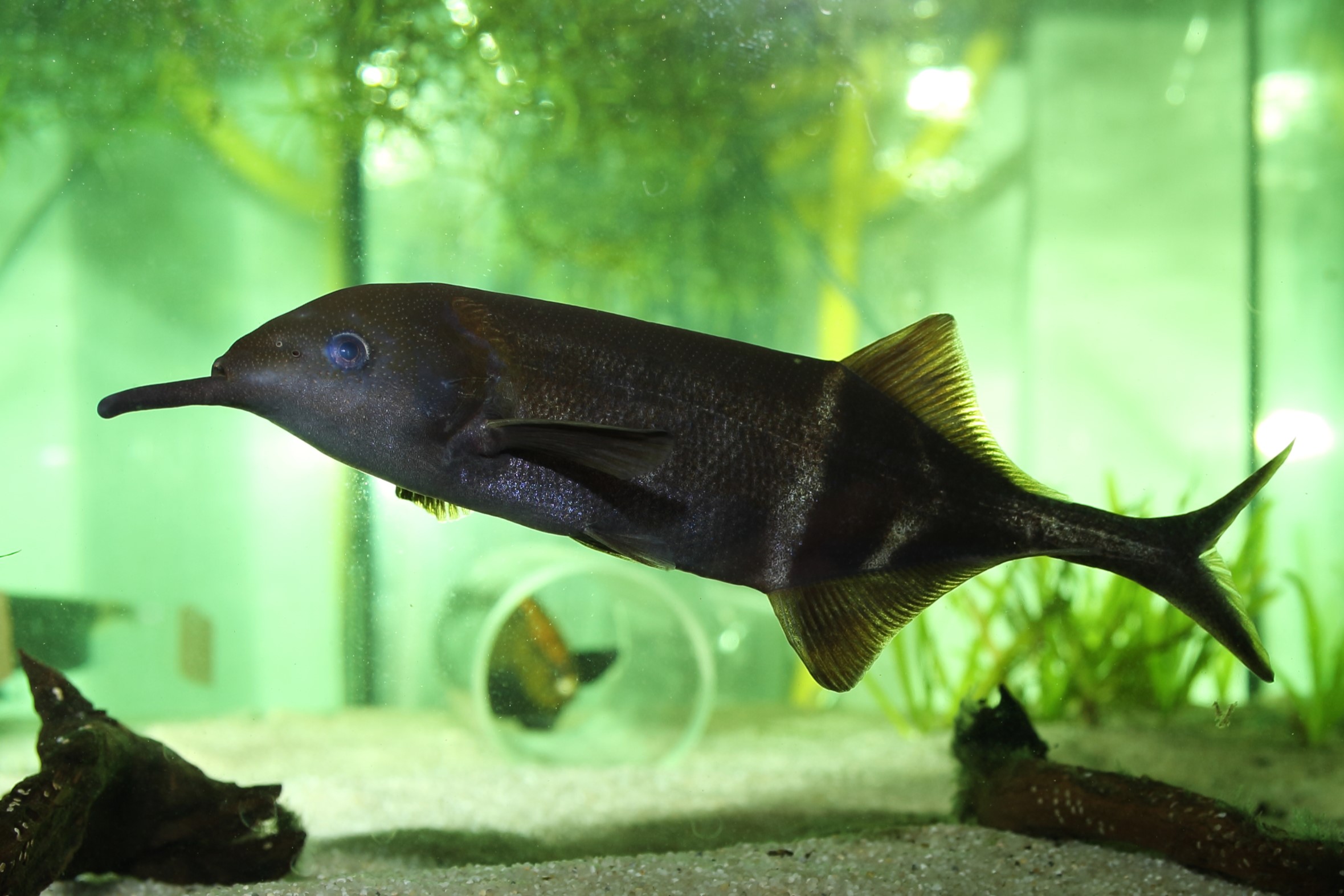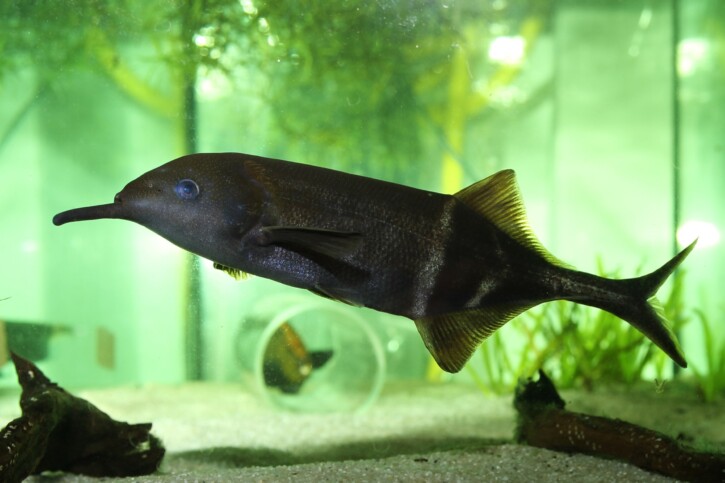elephantnose fish
| Scientific name | Gnathonemus petersii |
|---|---|
| Descriptor | Günther |
| Year of description | 1862 |
| IUCN category (World) | LC |
| Family | Mormyridae |
| Genus | Gnathonemus |


Introduction
Originating from rivers and lakes in West Africa, the elephantnose fish is an electric fish of the Mormyridae family.
Who is it?
Morphology
-
Average size28 cm
-
Maximum size35 cm
-
Longevity10 year
-
ShapeOval
-
Patternvertical stripes
-
Average size28 cm
-
Maximum size35 cm
-
Longevity10 year
-
ShapeOval
-
Patternvertical stripes
How to recognize This fish ?
The body is elongated, black, laterally compressed. The dorsal fin is very far back, at the same level as the anal fin. The thick fins participate in locomotion. Two white bands run horizontally across the body. The first extends from the first ray of the dorsal fin to the first ray of the anal fin, the second joins the middle of the two fins. These white bands fade with age.
The caudal fin is homocercal in V shape. Despite appearances, the trunk is not the nose, it is an outgrowth located on the fish's lower jaw. It is used to dig the ground in search of small prey. The mouth, small in size, is located above the "trunk".
This species has an electric emitting organ at the level of the caudal peduncle and a receiving electric organ at the head.
Sexual dimorphism
There is no visible sexual dimorphism in this species.
Behaviour & Life cycle
-
dietcarnivorous
-
Sociabilityliving in shoals
-
territorialNo
-
Way of livingdiurnal
The elephantnose fish lives in schools in its natural environment, with a hierarchy existing among individuals of the same school. The elephantnose fish is not known to be very aggressive towards fish of its own species or different species. However, in enclosed environments, individuals may kill each other.
The Gnathonemus petersii moves along the bottom while digging the substrate with its trunk in search of aquatic microorganisms. Hunting preferably occurs when the light is low or at night.
Reproduction
-
Reproductiondont le mode de reproduction est encore inconnu
The elephantnose fish is a species whose mode of reproduction is still unknown.
Harmless species
This species does not pose a particular danger to humans if encountered in its natural environment.
Origin and distribution
What is its habitat?
Natural environment characteristics
-
Temperature22 - 28 °C
-
pH (acidity)6 - 8
-
gh (hardness)5 - 19
Biotope presentation
The elephantnose fish lives in freshwater, in rivers, streams, and lakes in Central Africa. The water is generally rich in tannin or suspended matter, making visibility very poor. This species evolves on sandy and muddy bottoms in heavily planted areas littered with dead wood.
Fishkeeping
Not recommended
We do not recommend keeping this species in an aquarium. It has unpredictable needs which, if not met, generate significant stress, potentially leading to a shorter life expectancy, an interruption of its growth or the development of pathogens.
To go further
Sources & Contributions
Participation & Validation
The Fishipedia team and specialist contributors are committed to providing high-quality content. However, although the information comes from scientific sources or testimonials from specialists, the cards may contain inaccuracies.

Adrien Falzon

Benoit Chartrer
Translation
Translation done with the valuable contribution of our translators, who make this information available to a wider audience. We sincerely thank them for their commitment.
Bibliographic references
BRAIN AND BODY OXYGEN REQUIREMENTS OF GNATHONEMUS PETERSII, A FISH WITH AN EXCEPTIONALLY LARGE BRAIN - GÖRAN E. NILSSON - Journal of Experimental Biology - 1996.
FINDING FOOD: SENSES INVOLVED IN FORAGING FOR INSECT LARVAE IN THE ELECTRIC FISH GNATHONEMUS PETERSII - GERHARD VON DER EMDE - HORST BLECKMANN - Journal of Experimental Biology - 1998.
MOLECULAR SYSTEMATICS OF THE AFRICAN ELECTRIC FISHES (MORMYROIDEA: TELEOSTEI) AND A MODEL FOR THE EVOLUTION OF THEIR ELECTRIC ORGANS - JOHN P. SULLIVAN - SÉBASTIEN LAVOUÉ - Carl D. HOPKINS - Journal of Experimental Biology - 2000.
Scientific partners









